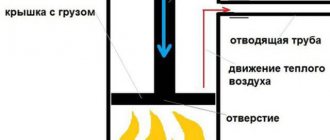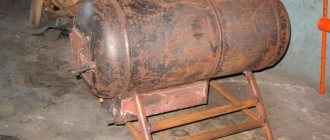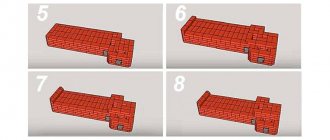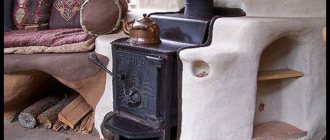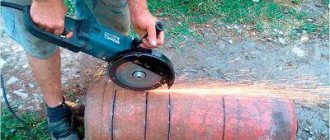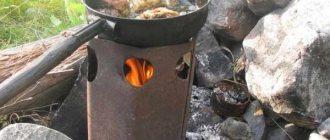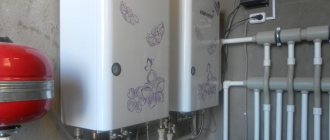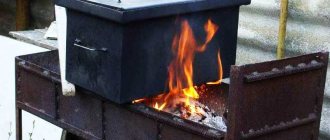Making a heating unit with your own hands from a cylinder
A thrifty owner carefully insulates his home, trying to reduce heating costs. In addition, there are a number of objects that need to be heated periodically: workshops, garages, outbuildings. It is necessary to regularly heat greenhouses or winter gardens.
Therefore, home craftsmen are constantly developing and implementing additional heating units of various designs. The most popular are products made from gas cylinders. The reason for this is the convenient shape and almost ideal proportions and characteristics of the material.
The efficiency of cylinder stoves reaches 85–90%, which is a very high figure in comparison with homemade stoves of other forms. The rounded shape is ideal for intensive pyrolysis of fuel and allows you to arrange openings for smoke exit and oxygen supply to the combustion zone at the lowest cost.
A simple and effective gas cylinder stove will last a long time
Operating principle of a potbelly stove
A potbelly stove is a primitive version of a metal wood-burning stove. This device works extremely simply: firewood is placed in the firebox, it burns, the stove body heats up and gives off heat to the surrounding air. Smoke gases are removed through the chimney, and the ash is poured through the grate into the ash pan, which should be cleaned periodically.
One of the main advantages of a potbelly stove is its simplicity of design. There are no strict dimensions here, the main thing is that the body can withstand heat and the chimney works properly. An experienced craftsman will make such a stove in just a couple of hours. And you can burn almost any dry wood in it: logs and sawdust. On our website there is an article with a detailed description of the process of making a potbelly stove with your own hands.
A potbelly stove is also heated with other flammable materials: diesel fuel, coal, peat, household waste, etc. If desired, you can cook quite successfully on such a stove. This point should be considered before the construction begins in order to create a smooth cooking surface.
A potbelly stove is a combustion chamber made of thick metal with a loading door, a chimney, a grate and an ash pit. You can use an old gas cylinder as a housing
But one should also take into account the disadvantages of such a heating solution. For starters, there is a high risk of burns and fires.
For the potbelly stove you need to choose a special place, decorated with fire-resistant materials. It is advisable for it to stand to the side, where no one will accidentally touch the body and get burned.
If desired, the upper part of a vertical potbelly stove from an old gas cylinder can be turned into a modest-sized hob
Such a metal structure weighs a lot, so we are not talking about any mobility of the device. It will be difficult to move a potbelly stove to heat different rooms.
Such stoves are usually used to heat utility rooms where there is no electricity or where it is supplied intermittently: garage, barn, workshop, etc.
From two gas cylinders connected perpendicularly, you can make an improved version of the potbelly stove, which allows you to retain more heat and get high efficiency when burning fuel
Another problem is low efficiency, since part of the thermal energy during the combustion of wood literally flies out into the chimney. There are various ways to retain heat and modify your stove slightly to make it work more efficiently.
Finally, you need to take care of good ventilation of the room in which the potbelly stove is installed, since such a device burns a large amount of oxygen during operation.
So, a potbelly stove consists of a metal body, the role of which is usually “invited” to be an old gas cylinder. It is necessary to make two doors in the case: large and small. The first serves to load fuel, the second is needed as a blower, through which air enters from the combustion chamber to ensure the combustion process and draft.
A drawing of a stove-stove from a gas cylinder allows you to make a device with specific parameters and calculated power, but such accuracy is not required
Below, at some distance from the bottom of the structure, a grate should be welded. It can be made from thick wire or simply take a sheet of thick metal and cut long slits in it. The distance between the grate rods should be such that the combustion material does not spill down into the ash pan.
If the potbelly stove will be heated only with wood, the gaps of the grate are made larger, but when it is intended to use wood chips, the grate should be made more frequent.
A curved metal chimney installed on a potbelly stove made from a gas cylinder allows you to retain more heat in the room and increase the efficiency of the structure
The ash box can be welded from sheet metal or take a ready-made metal container of a suitable size and resistant to strong heat. Some people prefer to do without an ash pan altogether, simply scooping out the ash from the lower section as needed, although this is not very convenient. As a rule, the chimney for a potbelly stove is oriented upward to provide the necessary draft.
The standard design of a gas cylinder stove can be modified to increase productivity by turning a solid fuel heater into a heater or hob:
What is a cylinder stove?
A classic representative of heating units from an old cylinder is the well-known “potbelly stove”. It received this name for its extraordinary gluttony, consuming large amounts of fuel. But its main advantage is fast ignition and heating. This is especially important in extreme situations, when for some reason the operation of the main heating stops.
In the design of such a furnace, the cylinders can be located in both vertical and horizontal positions. Heat transfer occurs through the surface of the furnace and can be significantly increased by welding metal ribs onto the surface. In addition, you can utilize the heat of flue gases by passing them through a pipe embedded in a container of water. Water heated in this way is used in a heating circuit or used in the household through an indirect heating boiler.
Pyrolysis furnaces occupy a special place in cylinder heating devices. Pyrolysis is the thermal decomposition of fuel that occurs with minimal access to oxygen. At temperatures above 300 degrees, the fuel in the furnace does not simply burn through the oxidation process, but decomposes into gas fractions, which give higher temperatures when ignited.
Photo gallery: types of stoves with a cylinder body
What cylinders can be used
Not every gas cylinder is suitable for making a furnace body. For example, it is not recommended to use cylinders made of composite materials. Despite its strength, the composite does not tolerate high temperatures.
A 5-liter container cannot serve as a furnace body due to its small size, but it is successfully used to make containers for liquid fuel.
You can use cylinders with a volume of 12 and 27 liters. They make excellent thermal units with a capacity of 2–3 kilowatts and 5–7 kilowatts, respectively.
Most often, stove bodies are made from cylinders with a capacity of 50 liters. Its dimensions - diameter 30 centimeters and height 85 - are optimal for installing a heating unit. A stove of this volume is capable of efficiently heating a small country house.
A 50-liter propane cylinder is best suited for the body of a homemade stove
Oxygen cylinders for furnaces are rarely used. The size ratio is not entirely convenient for the installation of a firebox, and the significant height makes such a unit unstable.
Important nuance
There are two types of gas used in everyday life. More precisely, two compositions of the gas mixture. And the characteristics of these mixtures differ greatly:
- Main gas , which consists of methane with an indicator - a strong-smelling component that allows you to quickly detect a leak. The main difference is that the mixture is lighter than air. Therefore, in a properly made furnace, a leak in the fittings is not a problem - the gas will simply go through the direct-flow system into the pipe, onto the street.
- A mixture of propane and butane is what is “packed” into cylinders at gas filling stations. This blend is better known as liquefied domestic gas. An important difference is that it weighs more than atmospheric air. As a result, in the event of a leak, it becomes very dangerous, since it can accumulate in the room or firebox of a stove converted to gas.
Hence the rule! You should not make your own stoves with gas burners designed for bottled gas.
And even the presence of a gas tank does not help - the same propane-butane mixture is filled into it.
Accordingly, if there is a gas main near the house, you can make a project, a permit and bring the pipe into the house. And instead of a boiler with a system of pipes, batteries or water circuit registers, install a furnace in which to burn gas.
But if only a bottled gas supply option is available, then there is no place for homemade products. We need to go a little different way.
Types of long-burning stoves from a gas cylinder
There are many options for making stoves from cylinders. Each home master makes his own changes to them, according to his capabilities and understanding of the process. At the same time, long-burning pyrolysis furnaces are the most popular. In such designs, the combustion time of the combustion material varies from 12 hours to a day or more, which can significantly reduce fuel consumption.
Furnaces with conical fuel stacking
A popular type of pyrolysis furnace is a design with conical fuel stacking. In such a furnace, a pin is installed along the axis of the firebox from the grate. When loading, a wooden or tin cone is placed on it with the base up. The firebox is filled from above with sawdust, shavings or wood chips. In this case, the combustion material must be compacted well so that the filling is as dense as possible.
When fuel is loaded, the cone must be pulled out and the lid closed. The fuel is ignited through a ash pit with a small amount of wood chips or a tablet of dry fuel. As soon as the fuel burns well, the ash door must be closed, limiting the flow of air into the firebox. Then the fuel simply smolders, but this is enough to reach the pyrolysis temperature. Smoke is discharged through a pipe in the upper part of the housing. With this design, “samovar” water heating tanks are also used for a radiator heating system or heating water in an indirect heating boiler. It is convenient to use a gas or oxygen cylinder as a heating container, passing the chimney pipe along the axis of the vessel. A fitting for hot water is welded in the upper part, and for return flow in the lower part. Circulation occurs naturally without the use of a pump, which makes the heating system energy independent.
A little more about the chimney
It is worth noting here that thanks to the design of the stove, which consists of two sections, a chimney pipe that is too long will not “steal” heat - an increase in draft will only contribute to increased combustion and an increase in temperature. The main thing is to secure it so that the wind does not uproot it. But it’s worth thinking about the deflector (protective cap). If there is snow or a blizzard at night, the pipe may become completely clogged. In this case, lighting a potbelly stove will be quite problematic. In the photo below you can see that I raised the chimney quite high. However, when this photo was taken, the deflector had not yet been installed.
This is the chimney pipe I got
Slow burning pyrolysis furnace “Bubafonya”
It is impossible to describe or simply list all the designs of stoves that can be made from cylinders, but it is advisable to consider in detail the “bubafonya” design. This model can be made at home with your own hands.
Safety
Before describing the design of the furnace and its manufacturing technology, let us pay attention to safety issues. We will talk about preparing the cylinder itself for processing. Despite its dense structure, the inner surface of the metal is riddled with a network of microscopic cracks. During long-term operation of the container for its intended purpose, a considerable amount of gas condensate and its sediment accumulates inside these defects. Such a substance may be explosive and is in no way beneficial to health. Before you start working with the cylinder, you need to fill it with water and let it sit for 2-3 days. It is better to perform the operation away from home. When the liquid is drained, the reasons for this recommendation will become clear - it has an extremely unpleasant and strong odor.
Video: how to safely disassemble a gas cylinder
Tools and materials for making the Bubafonya stove
To make such a heating unit with your own hands, you will need:
Table: required materials and tools
| Name | Purpose | Notes |
| Cylinder for furnace body | Manufacturing of the main product | boo |
| Steel rod with a diameter of 10 mm | Making handles for the oven lid and body | From waste |
| Angles 45x45, any profile, pipe cuttings | For support legs | From waste |
| Bulgarian | Cutting blank parts, cutting the cylinder during the manufacture of the body | |
| Steel sheet 6–10 millimeters thick | Making a pancake | |
| Steel strip 40x4 millimeters | Manufacturing of support ribs | |
| Cement, sand, gravel and fireclay bricks | Making the furnace support base | |
| Reinforcing bars | Foundation reinforcement | |
| Trowel, shovel, container for mixing the solution | Pouring the foundation | |
| Welding machine for working with ferrous metals and electrodes for it | Making welded joints when assembling the furnace | Possible to rent |
| Electric drill no less than 0.7 kW, set of metal drills | Drilling holes | |
| Measuring tool | Taking measurements and marking | |
| Locksmith's corner | Positioning of parts during assembly, quality control | |
| Kerner | Hole marking | |
| Files flat and semicircular | Removing sharp edges and burrs, adjusting dimensions | |
| Marker black | Marking production | |
| Individual protection means | Goggles, welder's mask, face shield, mittens, gloves, special shoes, rags. |
Preparing for assembly, choosing an installation location
Before starting work on assembling the stove, it is necessary to prepare the installation site. After pouring the foundation, it will take time for the concrete to harden. During this period, you can slowly make the stove itself. The foundation can be used no earlier than 7 days after pouring. On top of the concrete base you need to lay a platform of refractory bricks.
A high-quality foundation is necessary for safe operation of the furnace.
When choosing a place to install the stove, you need to consider the following circumstances:
- the distance to the nearest walls made of flammable material should be more than one meter; if there is no such place, the walls must be additionally protected from heating with an asbestos sheet 8–10 millimeters thick; install a sheet of galvanized metal 0.5–0.7 millimeters thick on top of it;
- the chimney in the vertical part should not fall on the supporting beam;
- if an external chimney with an outlet through the wall is used, the length of the horizontal part should not be more than one meter; otherwise, you need to make a chimney with a slope of 45 degrees.
It is better to prepare parts and assemble the stove indoors, for example, in a garage. This will save your neighbors from unnecessary noise when working with an angle grinder and from the sparkle of the electric welding arc. The room must be equipped with exhaust ventilation. If welding is carried out outdoors, the work area must be protected with protective screens.
Calculation methods and rules
The calculation rules have their own tolerances; you need to know them before calculating the diameter of the pipe. There are several calculation methods, they depend on who and for what conditions they will be fulfilled:
- High-precision, used in the production of boilers and carried out by the design departments of equipment manufacturers.
- Approximate calculations performed by non-specialists based on graphs, diagrams and tables.
- Automatic, obtained on the basis of online calculation.
Accurate calculations are understood as those in which many factors are taken into account: the temperature of the flue gases at the outlet of the boiler and from the pipe, the speed of movement of gases in the furnace and in sections of the smoke exhaust system, the loss of gas pressure along the movement in the gas-air tract. Most of these parameters were obtained experimentally by manufacturers of boiler equipment and depend on the brand of the boiler, so this type of calculation is practically not available to users.
In relation to the indicative method, before calculating the diameter of the chimney, the volume characteristics of the combustion chamber are taken into account. To determine the geometric parameters of pipes, there are various tables and graphs. For example, with a firebox dimensions of 500x400 mm, a round pipe from 180 to 190 mm will be required
For example, with a firebox with dimensions of 500x400 mm, a round pipe from 180 to 190 mm will be required.
The third method is based on the use of special online calculators. They take into account almost all important parameters, so they produce very accurate results. In order to use them, the operator will need to know a lot of starting data.
Exact method
Accurate calculations are based on a rather labor-intensive mathematical base. To do this, you will need to know the fundamental geometric characteristics of the pipe, heat generator and fuel used. For this calculation, you can use the following method for determining the diameter of a round pipe for a wood-burning stove.
Calculation input parameters:
- Gas T readings at the boiler outlet t – 151 C.
- The average speed of flue gases is 2.0 m/s.
- The estimated length of the pipe, which is standard for stoves, is 5 m.
- Mass of burned wood B= 10.0 kg/hour.
Based on these data, the volume of exhaust gases is first calculated:
V=[B*V*(1+t/272)]/3600 m3/sec
Where V is the volume of air masses that are necessary for complete combustion of fuel - 10 m3/kg.
V=10*10*1.55/3600=0.043 m3/sec
d=√4*V/3.14*2=0.166 mm
Swedish method
Chimney calculations are often performed using this method, although it is more accurate when calculating smoke exhaust systems for fireplaces with open fireboxes.
According to this method, the size of the combustion chamber and its gas volume are used for calculation. For example, for a fireplace with a portal, the height is 8 masonry heights and 3 masonry widths, which corresponds to the size F = 75.0 x 58.0 cm = 4350 cm2. The ratio F/f = 7.6% is calculated and it is determined from the graph that a rectangular chimney of this size cannot work; it is possible to use a structure with a circular cross-section, but its length must be at least 17 meters, which is not really high. In this case, it is better to make the choice from the opposite direction, according to the minimum required diameter section. It is easy to find by the height of the building, for example, for a 2-story house, the height from the fireplace to the chimney cap is 11 m.
F/f ratio = 8.4%. f = Fх 0.085 = 370.0 cm2
D= √4 x 370 / 3.14 = 21.7 cm.
Furnace modernization
Improving the operating parameters of the furnace is associated with an increase in its heat transfer. For this purpose, additional heat exchange surfaces are used on the furnace body. Such parts can be made from various metal profiles, including strips, angles, and profile pipes. The choice of material depends on what is available from leftovers.
Additional heat exchangers made of metal profiles increase the efficiency of the device
Additional heating surfaces can be installed not only on the outer surface, but also inside the firebox, which allows you to intensively heat the air in the room. A negative result of such a solution will be oxygen burnout at high temperatures.
Requirements
If the oven is used for cooking food, then one important problem arises. There must be a surface where food will be placed. At the same time, the heat flow in this place should be sufficient for high-quality cooking.
If, first of all, the tasks of heating the room are important, then other features come to the fore. Here the following are of particular importance:
- long burning;
- fuel efficiency;
- high requirements for fire safety.
The last requirement plays a vital role in the operation of various types of furnaces. However, when heating, the stove, in fact, can be left without direct supervision for a long time. This greatly increases the risk of an accidental fire. Another important issue is the possibility of legalizing a self-made stove. This process is not simple or easy.
Features of operation of a pyrolysis furnace
The main difference between pyrolysis furnaces is the ability to use a wide variety of fuels. In solid fuel stoves, it is possible to burn not only traditional flammable substances, but also rubber, plastic and other materials that are strictly not recommended for burning conventional stoves.
This feature is associated with complete decomposition of the fuel and secondary combustion of the resulting gases in a separate chamber. After this, only carbon dioxide and water vapor remain in the smoke emissions. No harmful emissions into the atmosphere occur during pyrolysis.
But when using such fuel at the ignition stage, a persistent smell of burnt rubber remains in the room. Therefore, such heating units must be installed outside residential premises.
Method of connecting gas cylinders to a heating boiler
The gas pressure is reduced using a reducer.
The containers are connected using a special reducer that converts the gas from a standard form to a gaseous one. When connecting a stove or stove, you can use a single gearbox for all containers or a separate gearbox for each. The first option will be less expensive. Several containers are connected to one boiler at once to increase the time between refills; a ramp is used for this purpose.
The wall thickness of gas pipes cannot be less than 2 mm. In areas where they pass through the walls, the pipes are foamed after being placed in separate cases. The boiler is connected to the gas pipeline using a flexible connection. For the gearbox, you can use a sleeve made of rubber fabric or a durite hose.
Gas cylinders must be installed at a distance of at least 2 meters from the boiler in a separate room or in a special gas cabinet with insulation.
